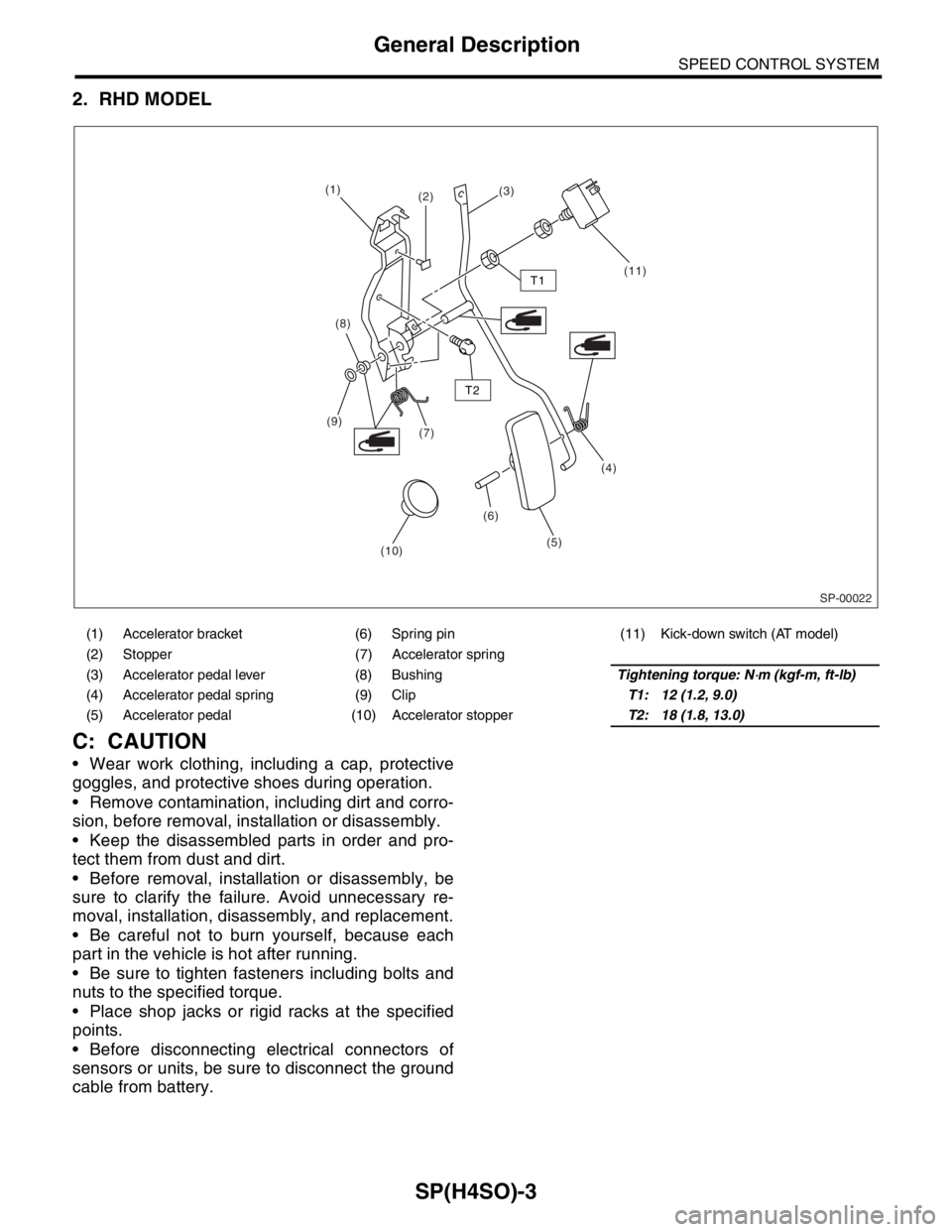Page 1056 of 2870

SP(H4SO)-3
SPEED CONTROL SYSTEM
General Description
2. RHD MODEL
C: CAUTION
Wear work clothing, including a cap, protective
goggles, and protective shoes during operation.
Remove contamination, including dirt and corro-
sion, before removal, installation or disassembly.
Keep the disassembled parts in order and pro-
tect them from dust and dirt.
Before removal, installation or disassembly, be
sure to clarify the failure. Avoid unnecessary re-
moval, installation, disassembly, and replacement.
Be careful not to burn yourself, because each
part in the vehicle is hot after running.
Be sure to tighten fasteners including bolts and
nuts to the specified torque.
Place shop jacks or rigid racks at the specified
points.
Before disconnecting electrical connectors of
sensors or units, be sure to disconnect the ground
cable from battery.
(1) Accelerator bracket (6) Spring pin (11) Kick-down switch (AT model)
(2) Stopper (7) Accelerator spring
(3) Accelerator pedal lever (8) BushingTightening torque: N
⋅m (kgf-m, ft-lb)
(4) Accelerator pedal spring (9) ClipT1: 12 (1.2, 9.0)
(5) Accelerator pedal (10) Accelerator stopperT2: 18 (1.8, 13.0)
SP-00022
(1)
(2)(3)
(11)
(8)
(7) (9)
(6)(4)
(5)
(10)
T1
T2
Page 1068 of 2870
IG(H4SO)-4
IGNITION
General Description
C: CAUTION
Wear working clothing, including a cap, protec-
tive goggles, and protective shoes during opera-
tion.
Remove contamination including dirt and corro-
sion before removal, installation or disassembly.
Keep the disassembled parts in order and pro-
tect them from dust or dirt.
Before removal, installation or disassembly, be
sure to clarify the failure. Avoid unnecessary re-
moval, installation, disassembly, and replacement.
Be careful not to burn yourself, because each
part on the vehicle is hot after running.
Be sure to tighten fasteners including bolts and
nuts to the specified torque.
Place shop jacks or rigid racks at the specified
points.
Before disconnecting electrical connectors of
sensors or units, be sure to disconnect the ground
cable from battery.
Page 1080 of 2870
SC(H4SO)-5
STARTING/CHARGING SYSTEM
General Description
C: CAUTION
Wear working clothing, including a cap, protec-
tive goggles, and protective shoes during opera-
tion.
Remove contamination including dirt and corro-
sion before removal, installation or disassembly.
Keep the disassembled parts in order and pro-
tect them from dust or dirt.
Before removal, installation or disassembly, be
sure to clarify the failure. Avoid unnecessary re-
moval, installation, disassembly, and replacement.
Be careful not to burn yourself, because each
part in the vehicle is hot after running.
Be sure to tighten fasteners including bolts and
nuts to the specified torque.
Place shop jacks or rigid racks at the specified
points.
Before disconnecting electrical connectors of
sensors or units, be sure to disconnect the ground
cable from battery.
Page 1097 of 2870

SC(H4SO)-22
STARTING/CHARGING SYSTEM
Battery
D: MEASUREMENT
WARNING:
Do not bring an open flame close to the bat-
tery at this time.
CAUTION:
Prior to charging, corroded terminals should
be cleaned with a brush and common baking
soda solution.
Be careful since the battery electrolyte over-
flows while charging the battery.
Observe the instructions when handling bat-
tery charger.
Before charging the battery on vehicle, dis-
connect battery ground terminal. Failure to fol-
low this rule may damage alternator’s diodes or
other electrical units.
1. JUDGMENT OF BATTERY IN CHARGED
CONDITION
1) Specific gravity of electrolyte is held at a specific
value in a range from 1.250 to 1.290 for more than
one hour.
2) Voltage per battery cell is held at a specific value
in a range from 2.5 to 2.8 volts for more than one
hour.
2. CHECK HYDROMETER FOR STATE OF
CHARGE
3. NORMAL CHARGING
Charge the battery at current value specified by
manufacturer or at approx. 1/10 of battery’s am-
pere-hour rating.
4. QUICK CHARGING
Quick charging is a method in which the battery is
charged in a short period of time with a relatively
large current by using a quick charger.
Since a large current flow raises electrolyte temper-
ature, the battery is subject to damage if large cur-
rent is used for prolonged time. For this reason, the
quick charging must be carried out within a current
range that will not increase the electrolyte temper-
ature above 40°C (104°F).
It should be also remembered that the quick charg-
ing is a temporary means to bring battery voltage
up to a fair value and, as a rule, a battery should be
charged slowly with a low current.CAUTION:
Observe the items in 3. NORMAL CHARGING.
Never use more than 10 amperes when
charging the battery because that will shorten
battery life.
Hydrometer
indicatorState of charge Required action
Green dot Above 65% Load test
Dark dot Below 65% Charge battery
Clear dot Low electrolyteReplace battery*
(If cranking complaint)
*: Check electrical system before replacement.
Page 1156 of 2870
EN(H4SO)-58
ENGINE (DIAGNOSTIC)
Diagnostics for Engine Starting Failure
B: STARTER MOTOR CIRCUIT
CAUTION:
After repair or replacement of faulty parts, conduct Clear Memory Mode
ERATION, Clear Memory Mode.> and Inspection Mode
tion Mode.>.
WIRING DIAGRAM:
EN-00261
12INHIBITOR SWITCH
STARTER
MOTOR
7P
RND321
SBF-4SBF-1
B14
B72
12
11
T7T3B12
13
IGNITION
SWITCH
1*2*
1*
2*
T7
123456789101112
B72
34
12
20
B136ECM
: AT MODEL
: MT MODEL1*
2*
BATTERY
B12
123456789101112
B136
5
2
84
3923 20 211011
221617
24
2512136
261915
14
1
7
18
Page 1159 of 2870
EN(H4SO)-61
ENGINE (DIAGNOSTIC)
Diagnostics for Engine Starting Failure
C: CHECK POWER SUPPLY AND GROUND LINE OF ENGINE CONTROL MOD-
ULE (ECM)
CAUTION:
After repair or replacement of faulty parts, conduct Clear Memory Mode
ERATION, Clear Memory Mode.> and Inspection Mode
tion Mode.>.
WIRING DIAGRAM:
EN-02381
B72
3412
BATTERYIGNITION
SWITCH MAIN RELAY
SBF-4SBF-1
SBF-5
B72B61F44
B2 B1 C12 C16
B21C5
A35
A7
C26
D14B9
C10 C23
No.11B47
E2 B21 1 2 3 5 6 4
ECM
EE
1
7
4
B134
B135
B136 A :
C :
D :B137 B :
C19
8
15
16 14 13
E
3412
56
123
4
56
78
9
1011 12
1314 15 16
B137B135B21B47
MT
MT
F44
B134
12345678
1234567891011121314151617181920212223242526272829303132333435
567
82 1
94
310
24 22 23 251112131415
26 27
281617181920 21
4
1
53
2618 15 167891011
17 19
20121314
B136
5
2
84
3923 20 211011
221617
24
2512136
261915
14
1
7
18
A : C :D :B :
LHDLHD
RHDRHD
Page 1162 of 2870
EN(H4SO)-64
ENGINE (DIAGNOSTIC)
Diagnostics for Engine Starting Failure
D: IGNITION CONTROL SYSTEM
CAUTION:
After repair or replacement of faulty parts, conduct Clear Memory Mode
ERATION, Clear Memory Mode.> and Inspection Mode
tion Mode.>.
WIRING DIAGRAM:
EN-00263
BATTERY
1 IGNITION
SWITCHSBF-44
A32
B21
E2
B134
1234567891011121314151617181920212223242526272829303132333435
B72
34
12
SBF-1No.11
54146
1234
B136 C:
B134 A:ECM
A33C26
34
12
IGNITOR
&
IGNITOR COIL ASSY
1234
E12B21
123
4
56
78
9
1011 12
1314 15 16
B72
B136
5
2
84
3923 20 211011
221617
24
2512136
261915
14
1
7
18
E12
C:
A:
Page 1165 of 2870
EN(H4SO)-67
ENGINE (DIAGNOSTIC)
Diagnostics for Engine Starting Failure
E: FUEL PUMP CIRCUIT
CAUTION:
After repair or replacement of faulty parts, conduct Clear Memory Mode
ERATION, Clear Memory Mode.> and Inspection Mode
tion Mode.>.
WIRING DIAGRAM:
EN-02382
B72B46
R15
F44
B99
B134
R58
3412
SBF-1
No.11SBF-4
E
1
2 4
B72
F44
B61
B46
R58R57R15
SBF-5
2134
4M14 1
B134ECM
341213
4562
12345678
1234567891011121314151617181920212223242526272829303132333435
BATTERY IGNITION
SWITCH
FUEL PUMP
RELAY
FUEL PUMP
7
B99
R7
B97
R186
LHD
LHDRHD
RHD
B97
12345678
RHD
LHD
LHD
RHD
E
123
45678